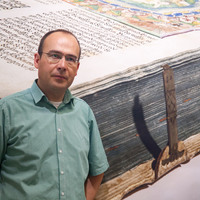Articles by Alexia Lagast

Queeste, 2015
Reisverslagen kennen een immer toenemende populariteit binnen de mediëvistiek en de studie v... more Reisverslagen kennen een immer toenemende populariteit binnen de mediëvistiek en de studie van de vroegmoderne tijd. Er is ook een groeiende aandacht voor reisverslagen uit de Nederlanden, waar ze rijkelijk zijn overgeleverd. In dat kader is een bloemlezing van reisverslagen van de Jeruzalemgangers uit de Nederlanden als die van Ben Wasser welkom. De teksten worden gepresenteerd in een origineel opzet waarbij een collage van kenmerkende passages uit de geselecteerde reisverhalen in dertien delen de gangbare structuur van een pelgrimsverslag volgt: de inleiding (I), de weg van huis tot Venetië (II), het oponthoud te Venetië (III), praktische raad (IV), de overtocht van Venetië naar Jaffa (V), de aankomst te Jaffa (VI), het bezoek aan Jeruzalem (VII), overige pelgrimages en verdere reizen in het Heilig Land, Hebron en Galilea (VIII), Syrië (IX), Egypte (X), de Sinaï (XI), Arabië, Perzië en India (XII), en tot slot de terugreis en thuiskomst (XIII). In de inleiding geeft de auteur een beknopte geschiedenis van het pelgrimsverslag in twaalf bladzijden (p. 13-24) met veel aandacht voor de historische context. Daarop volgt de bloemlezing in dertien delen, en tot slot volgt een korte karakterisering van elk van de opgenomen reisverslagen (p. 231-241). (...)

Publications du Centre Européen d'Etudes Bourguignonnes, 2016
Cette étude traite de la représentation de Mahomet dans le récit en moyen-néerlandais du pèlerina... more Cette étude traite de la représentation de Mahomet dans le récit en moyen-néerlandais du pèlerinage au Proche-Orient du noble flamand Josse de Ghistelles, rédigé par Ambrosius Zeebout (ca 1491), un texte qui compte parmi les plus importantes relations de voyage européennes médiévales. La source de cette représentation et le traitement que Ghistelles lui applique ont récemment attiré l’attention des chercheurs. En 1998, Renaat Gaspar avançait que la source principale de l’exposé sur Mahomet, dans le premier livre de l’œuvre de Josse, était le fameux récit de voyage de Bernhard von Breydenbach. Ce texte, écrit par le dominicain et professeur de théologie Martin Rath, est le premier récit de voyage à avoir été imprimé, en 1486, immédiatement après sa rédaction. Rath n’apparaît pas dans le texte – il n’a pas participé au pèlerinage, mais compose le récit à la première personne et au nom de Breydenbach.
Selon une hypothèse récente, Zeebout aurait adopté un ton plus neutre que sa source, le récit du voyage Breydenbach. En même temps, il a été remarqué que Zeebout aurait utilisé un langage dégradant. Il convient alors de se demander si le récit de Zeebout reste aussi neutre lorsqu’il décrit la vie de Mahomet, principal antagoniste de l’Occident chrétien. Le but de cette contribution est de vérifier le contenu et l’origine des modifications que Zeebout a pu apporter au discours de Rath. Tout d’abord, afin d’éclairer la neutralité supposée de l’exposé de Zeebout, j’analyserai son usage de langage dégradante, et de son plus neutre. Quand use-t-il ce dernier, et quand emploie-t-il le registre de l’injure?
Je considère en outre la spécificité de la description de la vie de Mahomet chez Zeebout: en quoi sa caractérisation du prophète diffère-t-il de celle de Rath?

(French and Dutch below)
ABSTRACT - The report of the voyage undertaken by the Flemish noblem... more (French and Dutch below)
ABSTRACT - The report of the voyage undertaken by the Flemish nobleman Joos van Ghistele at the end of the fifteenth century, is considered to be one of the most valuable European travel narratives. The text is unique, not only because of the voyage it contains – a four-year expedition that brought the travellers to the far north of Iran and to the southernmost point of the Red Sea – but especially due to the enormous amount of information it offers, and thanks to its critical character. The manuscript Brussels, RMAH, ms. 55.473, containing the narrative, is chronologically close to the text’s time of emergence. One would expect the identity and status of the noble traveller to be used as a way of authenticating the narrative. Surprisingly, the travellers remain anonymous in this manuscript. This is the case as well in the two other known manuscripts, while the status of the traveller could have caused for a considerable increase in the text’s credibility. It is not the social position, but the literary knowledge of the traveller and his capacity for empirical observation that are placed central. When the text is printed seventy years later, the traveller’s identity and status are elaborately used to promote the travel narrative. The analysis of this issue is followed by a guided tour of the voyage and of the narrative.
RÉSUMÉ – Le récit qui raconte le voyage du noble flamand Joos van Ghistele à la fin du quinzième siècle, est estimé être un des récits de voyage européens les plus riches. C’est un texte exceptionnel, non seulement en raison du voyage qu’il raconte – une épopée de quatre ans qui va mener les voyageurs jusqu’au nord de l’Iran et au sud de la Mer Rouge – mais surtout à cause de l’énorme quantité d’informations qu’il contient, et de sa nature critique. Le manuscrit Bruxelles, Musées royaux d’Art et d’Histoire, ms. 55.473 contenant le récit du voyage de Joos van Ghistele a été copié peu de temps après la rédaction du Voyage, probablement dans la même décade. Contre toute attente, les voyageurs restent anonymes tout au long du texte, et ce en dépit du fait que la mention de la position sociale des voyageurs aurait pu renforcer la crédibilité du récit. Au lieu de son statut, c’est la connaissance littéraire et la capacité d’observation des voyageurs qui sont mis en avant. À l’inverse, quand le récit sera imprimé un demi-siècle plus tard, l’imprimeur ne cachera ni l’identité de joos van Ghistele, ni celle de ses compagnons : il utilisera le prestige du noble voyageur pour promouvoir son livre. Faisant suite à l’analyse de ce problème, cet article esquisse un aperçu du récit, tout en offrant un l’éclaircissement sur le contexte historique
et les objectifs des voyageurs.
SAMENVATTING – Het verslag van de reis die de Vlaamse edelman Joos van Ghistele aan het einde van de vijftiende eeuw ondernam, wordt beschouwd als een van de meest waardevolle Europese reisverhalen. De tekst is uniek, niet alleen omwille van de reis die hij verhaalt – een expeditie van vier jaar die de reizigers tot in het verre noorden van Iran, en het zuidelijkste punt van de Rode Zee bracht – maar bovenal dankzij de enorme hoeveelheid informatie die hij biedt, en dankzij zijn kritische karakter. Het handschrift Brussel, KMKG, hs. 55.473 staat chronologisch dicht bij het ontstaan van de tekst. In tegenstelling tot de te verwachten aandacht voor de status van joos van Ghistele blijven de reizigers in dit handschrift voor de lezer onbekend. Dat is eveneens het geval in de twee andere bekende handschriften. Nochtans had de status van de reiziger de geloofwaardigheid van de tekst aanzienlijk kunnen versterken. In de plaats van maatschappelijk aanzien wordt de literaire kennis en de capaciteit van de reiziger voor empirische waarneming in de schijnwerpers gezet. Bij de uitgave in druk van de tekst een halve eeuw later, wordt de identiteit van joos van Ghistele en van zijn reisgenoten wel meegedeeld; er wordt van zijn status zelfs uitgebreid gebruikt gemaakt om het reisverhaal te promoten. Volgend op de analyse van dit vraagstuk schetst dit artikel een beeld van het reisverhaal, vergezeld van toelichting over de historische context en de ideeën en intenties van de reizigers.

Millennium, tijdschrift voor middeleeuwse studies, Jan 2010
In the prologue of medieval animal epic Van den vos Reynaerde, the writer presents himself as 'W... more In the prologue of medieval animal epic Van den vos Reynaerde, the writer presents himself as 'Willem, who made Madocke'. In one of the three known manuscripts of Van den vos Reynaerde, 'Madocke' has been erased and replaced by 'vele boucke' ('many books'). Does this explain why Madocke was never found? The only evidence we have are references in other texts, often by use of the phrase 'Madocs droom' ('Madocs dream'), which obviously refers to some altered state of consciousness. In total, Madocke is mentioned in two Flemish texts from the thirteenth and one from the fourteenth century, already in a corrupted way in a sixteenth-century play and in two sixteenth century,Western Flemish refrains. There might also have been a remainder of the expression 'Madocs dream' in nineteenth century Western Flemish dialect. A critical analysis of these references and of nearly two hundred years of hypothesis, shows that the most certain and important element is that 'Madocs dream' was a state of mind in which impossible things occurred. The cynical character of Willem's Van den vos Reynaerde makes it probable that Madoc was a mock story about a journey or a vision, in which Madoc travelled through an illusory world. Another interesting element is that 'madoc' is a Celtic epitheton for 'fox', a literary name that prevailed over the common word for fox, like 'renard' predominated 'goupil' in French because of the influence of the Roman de Renard. It is possible that story material was transferred to Flanders due to extensive contacts between Flanders and the Celtic regions after Flemish colonists had settled the Welsh frontier regions in the wake of the English conquests in Wales. If Madoc describes a mock-journey, the animal epic would have been the perfect literary genre in order to criticize authorities, as Willem also did in the Reynart story. In conclusion, Madoc might have been an animal epic, like Van den vos Reynaerde, in which Madoc, possibly a fox, made an imaginary journey through a land where the impossible was possible.
Talks by Alexia Lagast
Hated, or loved? Cunning and shrewd, or ignorant and aggressive? Devilish and bestial, or simply ... more Hated, or loved? Cunning and shrewd, or ignorant and aggressive? Devilish and bestial, or simply human? These are some of the characteristics of the prophet Muhammad on which the travel narratives of late fifteenth century travellers Bernhard von Breydenbach and Joos van Ghistele disagreed. The introductory chapter of Van Ghistele’s account (c. 1491) contains a Vita Mahometi largely based on the Vita included in Breydenbach’s travel account (1486). Even though Ambrosius Zeebout, the author of Van Ghistele’s account, used Breydenbach’s description of the prophet’s life as a source, both accounts give very different representations of the prophet. In this talk, I provide in-depth analysis of these divergent representations, and of the accounts’ respective representations of the Islamic people.

The Flemish account relating the four-year journey to the East (1481-5) undertaken by the Flemish... more The Flemish account relating the four-year journey to the East (1481-5) undertaken by the Flemish nobleman Joos van Ghistele (†1516), written by Ambrosius Zeebout (c. 1491), is counted as one of the most important early modern western travel narratives. Joos’ elaborate journey – which he undertook because he wanted to “see with his own eyes what he had heard and had read in several books” – led as far as Tabriz in present-day Iran and through Egypt to the island Perim in the mouth of the Red Sea. The account’s learned writer combined and critically contrasted the traveller’s notes with over 60 written sources (mainly Latin), resulting in an extensive account (400 fol.) which has been continuously praised in travel narrative studies for its exceptionally informative, critical and even humanistic character. In an introductory chapter the account contains a Vita Mahometi largely based on the Vita included in Bernhard von Breydenbach’s travel account (1486), but claimed in recent scholarship to be milder in tone than its source. The opposite, however, appears to be the case: the author in fact added explicit insults to his description of Muhammad and changed his characterisation. Even though Zeebout used Breydenbach’s description of the life of Muhammad as a source, both accounts give very different representations of the prophet. The accounts’ respective representations of the Islamic people differ as well. Indeed while Zeebout’s life of Muhammad is adapted to effectively vilify the prophet, his description of the Islamic people is remarkably ethnographic.
This paper examines how the sharing of sacred space among the Semitic religions is depicted in de... more This paper examines how the sharing of sacred space among the Semitic religions is depicted in descriptions of Jerusalem and of St. Catherine’s monastery in Western travel narratives on the Orient from 1470-1500. My comparative research reveals that while the descriptions of the sharing of religious shrines are imbued with a discourse of rivalry, these texts demonstrate that the traditional Latin Christian antagonist attitude towards non-Christian religiosity is abated by exhibitions of tolerance and respect for the devotion of its contenders.
Cet exposé traite des récits de voyage de la fin du quinzième siècle. Ce sont des récipients tres... more Cet exposé traite des récits de voyage de la fin du quinzième siècle. Ce sont des récipients tres divers de nouvelles informations sur des territoires inconnus, basés sur l’expérience des voyageurs autant que sur des sources littéraires. Les descriptions des nouveaux territoires du pèlerinage, surtout de l’Egypte, contiennent souvent des comparaisons avec des phénomènes occidentaux. Ce procédé permettait à l’auteur du récit de donner au public une impression plus tangible du phénomène étranger. Dans cet exposé je vais étudier les comparaisons dans quelques-uns de ces récits et en explorer l’origine.
Early modern travel narratives are receptacles of all kinds of information on the explored territ... more Early modern travel narratives are receptacles of all kinds of information on the explored territories, based on the experience of the travelers as well as on literary sources. The descriptions of these territories and the new elements in them often contain comparisons to western phenomena. The rhetorical tool of comparison to translate the unfamiliar for the reader is called the simile, and it dates back to Herodotos. The simile helps to bridge the gap of knowledge between the traveler-author and the reader, through comparison of the unfamiliar with the familiar. It enables the reader to see how things are, and prompts them to believe it by making it realistic. Are these comparisons a product of the travelers’ eye witness reports, or were they inspired by literary sources?
Blog posts by Alexia Lagast

Blog of the Leverhulme-Birkbeck college project "Pilgrim libraries", 2017
A couple of months ago, I decided to take a spontaneous trip to Prague. At my host’s charming tur... more A couple of months ago, I decided to take a spontaneous trip to Prague. At my host’s charming turn-of-the-century apartment, I found a Dutch guidebook containing historical background information on the city, which I soon found myself reading in the comfort of a rocking chair beside the piano. While visiting the city, I had no use for the guidebook: I like to discover for myself. It dawned on me that I have much in common with the two travellers who have accompanied me on the journey of my Ph.D. research. They, too, wished “to see with their own eyes what they had heard and had read in several books,” as we can read in their travel report (c. 1490). They were the Flemish nobleman Joos van Ghistele (†1516), and his chaplain, Jan Quisthout († 1489). Together, they travelled the Middle East for four years (1481-5). (...)
Papers by Alexia Lagast

Publications du Centre Européen d'Etudes Bourguignonnes, 2016
Cette étude traite de la représentation de Mahomet dans le récit en moyennéerlandais du pèlerinag... more Cette étude traite de la représentation de Mahomet dans le récit en moyennéerlandais du pèlerinage au Proche-Orient du noble flamand Josse de Ghistelles, rédigé par Ambrosius Zeebout (ca 1491), un texte qui compte parmi les plus importantes relations de voyage européennes médiévales 1 • La source de cette représentation et le traitement que Ghistelles lui applique ont récemment attiré l'attention des chercheurs. En 1998, Renaat Gaspar avançait que la source principale de l'exposé sur Mahomet, dans le premier livre de l'oeuvre de Josse, était le fameux récit de voyage de Bernhard von Breydenbach 2 • Ce texte, écrit par le dominicain et professeur de théologie Martin Rath, est le premier récit de voyage à avoir été imprimé, en 1486, immédiatement après sa rédaction. Ratb. Antoon Viaene considérait ce texte comme l'« un des meilleurs récits de voyage médiévaux sur l'Orient», et Istvén Bejczy le qualifiait de «très complet et exceptionnellement précis, le plus élaboré dans la littérature des Pays-Bas, et un des plus captivants dans son genre ». A. VIAENE, Vlaamse pelgrimstochten. Een verzameling opstellen over bedevaarten en bedevaarders vanuit Vlaanderen in de late middeleeuwen, Bruges, 1982, p. 196; I. BEJCZV, Between Mandeville and Columbus. Tvoyage by Joas van Ghistele, dans Travel Fact and Travel Fiction. Studies on Fiction, Literary Tradition, Scholarly Discovery and Observation in Travel Writing, éd. Z. VON MARTELS, Leyde-New York-Cologne, 1994 (Brill's Studies in Intellectual History, 55), p. 85-86. La description de la prise de Chypre par les Vénitiens, dans le cinquième livre, aux deux-tiers du récit, permet de proposer une date de rédaction de celui-ci postérieure à 1489. AMBROSIUS ZEEBOUT, Tvoyage van Mher Joos van Ghistele, éd.

The report of the voyage undertaken by the Flemish nobleman Joos van Ghistele at the end of the f... more The report of the voyage undertaken by the Flemish nobleman Joos van Ghistele at the end of the fifteenth century, is considered to be one of the most valuable European travel narratives. The text is unique, not only because of the voyage it contains – a four-year expedition that brought the travellers to the far north of Iran and to the southernmost point of the Red Sea – but especially due to the enormous amount of information it offers, and thanks to its critical character. The manuscript Brussels, RMAH, ms. 55.473, containing the narrative, is chronologically close to the text's time of emergence. One would expect the identity and status of the noble traveller to be used as a way of authenticating the narrative. Surprisingly, the travellers remain anonymous in this manuscript. This is the case as well in the two other known manuscripts. While the status of the traveller could have caused for a considerable increase in the text's credibility, it his not the social positio...

In the prologue of medieval animal epic Van den vos Reynaerde, the writer presents himself as ... more In the prologue of medieval animal epic Van den vos Reynaerde, the writer presents himself as 'Willem, who made Madocke'. In one of the three known manuscripts of Van den vos Reynaerde, 'Madocke' has been erased and replaced by 'vele boucke' ('many books'). Does this explain why Madocke was never found? The only evidence we have are references in other texts, often by use of the phrase 'Madocs droom' ('Madocs dream'), which obviously refers to some altered state of consciousness. In total, Madocke is mentioned in two Flemish texts from the thirteenth and one from the fourteenth century, already in a corrupted way in a sixteenth-century play and in two sixteenth century,Western Flemish refrains. There might also have been a remainder of the expression 'Madocs dream' in nineteenth century Western Flemish dialect. A critical analysis of these references and of nearly two hundred years of hypothesis, shows that the most certain and...











Uploads
Articles by Alexia Lagast
Selon une hypothèse récente, Zeebout aurait adopté un ton plus neutre que sa source, le récit du voyage Breydenbach. En même temps, il a été remarqué que Zeebout aurait utilisé un langage dégradant. Il convient alors de se demander si le récit de Zeebout reste aussi neutre lorsqu’il décrit la vie de Mahomet, principal antagoniste de l’Occident chrétien. Le but de cette contribution est de vérifier le contenu et l’origine des modifications que Zeebout a pu apporter au discours de Rath. Tout d’abord, afin d’éclairer la neutralité supposée de l’exposé de Zeebout, j’analyserai son usage de langage dégradante, et de son plus neutre. Quand use-t-il ce dernier, et quand emploie-t-il le registre de l’injure?
Je considère en outre la spécificité de la description de la vie de Mahomet chez Zeebout: en quoi sa caractérisation du prophète diffère-t-il de celle de Rath?
ABSTRACT - The report of the voyage undertaken by the Flemish nobleman Joos van Ghistele at the end of the fifteenth century, is considered to be one of the most valuable European travel narratives. The text is unique, not only because of the voyage it contains – a four-year expedition that brought the travellers to the far north of Iran and to the southernmost point of the Red Sea – but especially due to the enormous amount of information it offers, and thanks to its critical character. The manuscript Brussels, RMAH, ms. 55.473, containing the narrative, is chronologically close to the text’s time of emergence. One would expect the identity and status of the noble traveller to be used as a way of authenticating the narrative. Surprisingly, the travellers remain anonymous in this manuscript. This is the case as well in the two other known manuscripts, while the status of the traveller could have caused for a considerable increase in the text’s credibility. It is not the social position, but the literary knowledge of the traveller and his capacity for empirical observation that are placed central. When the text is printed seventy years later, the traveller’s identity and status are elaborately used to promote the travel narrative. The analysis of this issue is followed by a guided tour of the voyage and of the narrative.
RÉSUMÉ – Le récit qui raconte le voyage du noble flamand Joos van Ghistele à la fin du quinzième siècle, est estimé être un des récits de voyage européens les plus riches. C’est un texte exceptionnel, non seulement en raison du voyage qu’il raconte – une épopée de quatre ans qui va mener les voyageurs jusqu’au nord de l’Iran et au sud de la Mer Rouge – mais surtout à cause de l’énorme quantité d’informations qu’il contient, et de sa nature critique. Le manuscrit Bruxelles, Musées royaux d’Art et d’Histoire, ms. 55.473 contenant le récit du voyage de Joos van Ghistele a été copié peu de temps après la rédaction du Voyage, probablement dans la même décade. Contre toute attente, les voyageurs restent anonymes tout au long du texte, et ce en dépit du fait que la mention de la position sociale des voyageurs aurait pu renforcer la crédibilité du récit. Au lieu de son statut, c’est la connaissance littéraire et la capacité d’observation des voyageurs qui sont mis en avant. À l’inverse, quand le récit sera imprimé un demi-siècle plus tard, l’imprimeur ne cachera ni l’identité de joos van Ghistele, ni celle de ses compagnons : il utilisera le prestige du noble voyageur pour promouvoir son livre. Faisant suite à l’analyse de ce problème, cet article esquisse un aperçu du récit, tout en offrant un l’éclaircissement sur le contexte historique
et les objectifs des voyageurs.
SAMENVATTING – Het verslag van de reis die de Vlaamse edelman Joos van Ghistele aan het einde van de vijftiende eeuw ondernam, wordt beschouwd als een van de meest waardevolle Europese reisverhalen. De tekst is uniek, niet alleen omwille van de reis die hij verhaalt – een expeditie van vier jaar die de reizigers tot in het verre noorden van Iran, en het zuidelijkste punt van de Rode Zee bracht – maar bovenal dankzij de enorme hoeveelheid informatie die hij biedt, en dankzij zijn kritische karakter. Het handschrift Brussel, KMKG, hs. 55.473 staat chronologisch dicht bij het ontstaan van de tekst. In tegenstelling tot de te verwachten aandacht voor de status van joos van Ghistele blijven de reizigers in dit handschrift voor de lezer onbekend. Dat is eveneens het geval in de twee andere bekende handschriften. Nochtans had de status van de reiziger de geloofwaardigheid van de tekst aanzienlijk kunnen versterken. In de plaats van maatschappelijk aanzien wordt de literaire kennis en de capaciteit van de reiziger voor empirische waarneming in de schijnwerpers gezet. Bij de uitgave in druk van de tekst een halve eeuw later, wordt de identiteit van joos van Ghistele en van zijn reisgenoten wel meegedeeld; er wordt van zijn status zelfs uitgebreid gebruikt gemaakt om het reisverhaal te promoten. Volgend op de analyse van dit vraagstuk schetst dit artikel een beeld van het reisverhaal, vergezeld van toelichting over de historische context en de ideeën en intenties van de reizigers.
Talks by Alexia Lagast
Blog posts by Alexia Lagast
Papers by Alexia Lagast
Selon une hypothèse récente, Zeebout aurait adopté un ton plus neutre que sa source, le récit du voyage Breydenbach. En même temps, il a été remarqué que Zeebout aurait utilisé un langage dégradant. Il convient alors de se demander si le récit de Zeebout reste aussi neutre lorsqu’il décrit la vie de Mahomet, principal antagoniste de l’Occident chrétien. Le but de cette contribution est de vérifier le contenu et l’origine des modifications que Zeebout a pu apporter au discours de Rath. Tout d’abord, afin d’éclairer la neutralité supposée de l’exposé de Zeebout, j’analyserai son usage de langage dégradante, et de son plus neutre. Quand use-t-il ce dernier, et quand emploie-t-il le registre de l’injure?
Je considère en outre la spécificité de la description de la vie de Mahomet chez Zeebout: en quoi sa caractérisation du prophète diffère-t-il de celle de Rath?
ABSTRACT - The report of the voyage undertaken by the Flemish nobleman Joos van Ghistele at the end of the fifteenth century, is considered to be one of the most valuable European travel narratives. The text is unique, not only because of the voyage it contains – a four-year expedition that brought the travellers to the far north of Iran and to the southernmost point of the Red Sea – but especially due to the enormous amount of information it offers, and thanks to its critical character. The manuscript Brussels, RMAH, ms. 55.473, containing the narrative, is chronologically close to the text’s time of emergence. One would expect the identity and status of the noble traveller to be used as a way of authenticating the narrative. Surprisingly, the travellers remain anonymous in this manuscript. This is the case as well in the two other known manuscripts, while the status of the traveller could have caused for a considerable increase in the text’s credibility. It is not the social position, but the literary knowledge of the traveller and his capacity for empirical observation that are placed central. When the text is printed seventy years later, the traveller’s identity and status are elaborately used to promote the travel narrative. The analysis of this issue is followed by a guided tour of the voyage and of the narrative.
RÉSUMÉ – Le récit qui raconte le voyage du noble flamand Joos van Ghistele à la fin du quinzième siècle, est estimé être un des récits de voyage européens les plus riches. C’est un texte exceptionnel, non seulement en raison du voyage qu’il raconte – une épopée de quatre ans qui va mener les voyageurs jusqu’au nord de l’Iran et au sud de la Mer Rouge – mais surtout à cause de l’énorme quantité d’informations qu’il contient, et de sa nature critique. Le manuscrit Bruxelles, Musées royaux d’Art et d’Histoire, ms. 55.473 contenant le récit du voyage de Joos van Ghistele a été copié peu de temps après la rédaction du Voyage, probablement dans la même décade. Contre toute attente, les voyageurs restent anonymes tout au long du texte, et ce en dépit du fait que la mention de la position sociale des voyageurs aurait pu renforcer la crédibilité du récit. Au lieu de son statut, c’est la connaissance littéraire et la capacité d’observation des voyageurs qui sont mis en avant. À l’inverse, quand le récit sera imprimé un demi-siècle plus tard, l’imprimeur ne cachera ni l’identité de joos van Ghistele, ni celle de ses compagnons : il utilisera le prestige du noble voyageur pour promouvoir son livre. Faisant suite à l’analyse de ce problème, cet article esquisse un aperçu du récit, tout en offrant un l’éclaircissement sur le contexte historique
et les objectifs des voyageurs.
SAMENVATTING – Het verslag van de reis die de Vlaamse edelman Joos van Ghistele aan het einde van de vijftiende eeuw ondernam, wordt beschouwd als een van de meest waardevolle Europese reisverhalen. De tekst is uniek, niet alleen omwille van de reis die hij verhaalt – een expeditie van vier jaar die de reizigers tot in het verre noorden van Iran, en het zuidelijkste punt van de Rode Zee bracht – maar bovenal dankzij de enorme hoeveelheid informatie die hij biedt, en dankzij zijn kritische karakter. Het handschrift Brussel, KMKG, hs. 55.473 staat chronologisch dicht bij het ontstaan van de tekst. In tegenstelling tot de te verwachten aandacht voor de status van joos van Ghistele blijven de reizigers in dit handschrift voor de lezer onbekend. Dat is eveneens het geval in de twee andere bekende handschriften. Nochtans had de status van de reiziger de geloofwaardigheid van de tekst aanzienlijk kunnen versterken. In de plaats van maatschappelijk aanzien wordt de literaire kennis en de capaciteit van de reiziger voor empirische waarneming in de schijnwerpers gezet. Bij de uitgave in druk van de tekst een halve eeuw later, wordt de identiteit van joos van Ghistele en van zijn reisgenoten wel meegedeeld; er wordt van zijn status zelfs uitgebreid gebruikt gemaakt om het reisverhaal te promoten. Volgend op de analyse van dit vraagstuk schetst dit artikel een beeld van het reisverhaal, vergezeld van toelichting over de historische context en de ideeën en intenties van de reizigers.